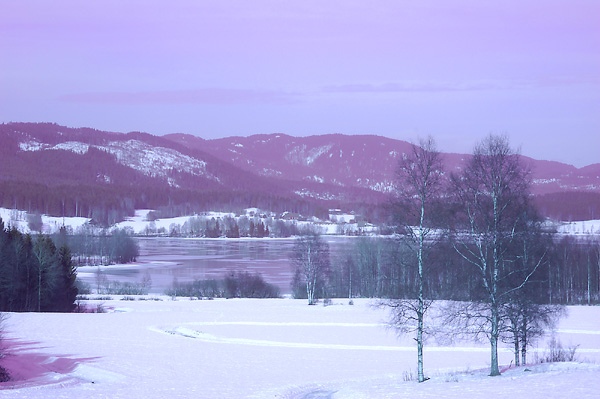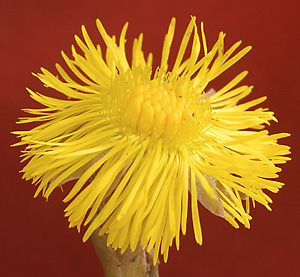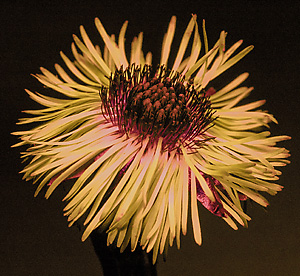 |
| Ultra-Violet
Landscape Nikon D70, EL-Nikkor 63 mm f/3.5 lens*, using a filter pack of B+W BG-38 and Wratten 18A (gel)**. 4 sec exposure at f/11 @ 200 "ISO", NEF format * in a home-made focusing mount so
it will focus to infinity |
| Nikon D70 Digital Camera Reviewed | |
| by Bjørn Rørslett | |
7. Ultra-Violet (UV) Photography With D70
I love to shoot in ultra-violet (UV) and have pressed each and every of my numerous digital SLRs into such service. Since my trustworthy UV-Nikkor 105 mm lens has been modified by adding a CPU to it, it is fully compatible even with the crippled metering facilities of D70. Thus, I could initiate a comprehensive test shooting scheme with D70 and an array of lens and filter combinations.
The camera designers don't like UV any more than they do IR penetrating into their digital contraptions. However, unlike IR, the UV rays are quite efficiently filtered out by pure optical means long before they can reach the imaging chip inside. The optical glass in the lens, and in particular the multi-coating layers, prevent much of the impinging UV to pass through. Using lenses which transmit UV more freely, in conjunction with the appropriate filtration over the lens, helps you achieve better UV imagery. Since D70, as most other DSLRs do, respond to near-IR radiation as well, mitigating adverse IR effects by adding IR-blocking filters is crucial. Test shooting has confirmed that the B+W BG-38 filter does this job nicely with most DSLRs, so this blue-green filter should always be used for UV photography. On the other hand, if you decide to make esoteric images in which the eerie combination of UV and IR sets the mood, don't forget to remove the BG-38 before shooting commences.
D70 responds to UV mostly in the red channel, just like the D1-series, but there is useful response in the other two channels as well. However, the response in the green channel is quite low, and this might cause a slight trouble for colour-balancing my UV flower shots the way I prefer to. in these respects, D70 behaves quite similar to my D2H, and I haven't yet decided which of these two cameras is to be preferred for general UV work. suffice to say both will be up to the task, each in its own manner.
At the time of writing, the ground around here is still covered with snow and the spring flowers, excellent test subjects for UV photography, are hardly to be found. Hence, I had to resort to my standard scenic test area, see below. For this shot, my new-found little UV lens, the EL-Nikkor 63 mm f/3.5 in its homemade focusing mount, did a splendid job of capturing the hazy mood so typical for UV landscapes. My D2H gave me very similar images with nearly identical exposures, so judged from this UV session, both cameras exhibited similar UV sensitivity.
 |
| Ultra-Violet
Landscape Nikon D70, EL-Nikkor 63 mm f/3.5 lens*, using a filter pack of B+W BG-38 and Wratten 18A (gel)**. 4 sec exposure at f/11 @ 200 "ISO", NEF format * in a home-made focusing mount so
it will focus to infinity |
Some days later, during a brief spell of spring thaw, I nipped some colt's foot flowers in the bud as it were. They were immediately made the victims of a UV-Nikkor lens on my D70, and probably survived longer this way than at their native habitat which just hours later once more became packed with snow.
 |
 |
| Visible light: f/22, L37C filter on lens | Ultra-Violet: f/11, SB-140 Flash with SW5-UV filter over the flash head |
| Colt's Foot (Tussilago
farfara) in Ultra-Violet Nikon D70, UV-Nikkor 105 mm f/4.5 lens, using a filter pack of B+W BG-38 with B+W 403 (Wratten 18A equivalent) for UV Both images shot @ 800 "ISO", NEF format |
|
Under UV light, the flower heads are
depicted with the typical "bull's-eye" pattern found so ubiquitously amongst flowers. This test
demonstrates that D70 is capable of recording true UV images, and
with a lot of detail as well. This time, I chose to
colour-balance the UV shot to appear very similar to the
visible-light reference, so the differences would be readily
apparent. Further test shooting with flowers more UV-reflective
than the colt's foot should show whether or not this approach is
feasible in general for my UV flower work. Until now, I have
mainly colour-balance digital UV flower shots to be similar to
the way they record on colour films, Fuji RTP being my standard
reference here.
After extensive field testing during the early summer, 2004, I concluded that D70 has the better UV capability compared to either my old reference, D1H, or the new runner-up, D2H. Accordingly I now pack the D70 with all my specialised gear for UV photography. A little strange to deploy an "amateur" camera for this kind of professional work, but here as elsewhere the proof is given by the images, not by the price tag of the equipment.
For people interested in trying out UV
photography with their D70, I recommend reading my UV/IR tutorial to get the central ideas and concepts in place.
Thereafter, scavenge local camera stores and flea markets for
suitable optics and set out to explore what the camera can see,
but which is hidden from your eyesight. Not seeing something
doesn't mean it is non-existing.